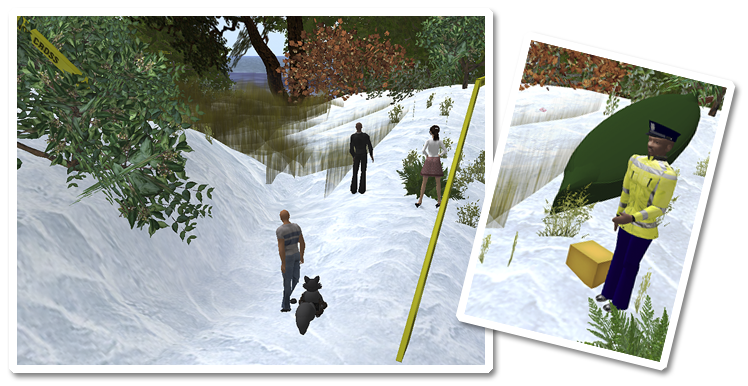Interactive Virtual Crime Scene in Second Life Don Lehman and Firery Broome
Fall 2009

In the Introduction to Forensic Science course, I discuss the history of forensic science, the collection and transportation of crime scene evidence, and the role of forensic scientists. I also present the principles of forensic testing in the areas of immunologic assays, DNA analysis, fingerprinting, toxicology, arson, and bioterror. The learning goals for this course are to facilitate the student’s ability to understand the principles and methodologies of forensic science and to apply this knowledge to the interpretation of test data. By attaining these goals, students will gain an understanding of the relevance and impact of forensic science.

In this course, students investigate a crime scene in Second Life. Virtual crime scenes are an excellent use of Second Life as a digital teaching tool. It is possible to create several different scenarios incorporating many principles covered in class, e.g., DNA analysis, fingerprinting, toxicology, etc. A single crime scene could be programmed with different test results offering a number of different learning opportunities. Second Life offers the flexibility and complexity to provide a “capstone” experience in this course.
The course was taught for the first time the fall semester 2009. Students were required to attend a face-to-face classroom session for an orientation to Second Life’s interface and navigation. Additionally, in-world help and a review session were provided as the time to enter the crime scene drew near. Students were given a landmark to the crime scene where a police officer prim greeted them with a notecard of instructions and items needed to proceed with the investigation.
 We collaborated with Dr. Allen Partridge who generously modified his game quiz tool to work with our quiz information and delivery requirements. The exercise was interactive in that all evidence was scripted using the game tool scripts, students had to navigate the crime scene and decide on the appropriate investigatory steps and, finally, the students were asked multiple choice questions about evidence they found. The students, who worked in pairs, could also discuss evidence in real time at the crime scene.
We collaborated with Dr. Allen Partridge who generously modified his game quiz tool to work with our quiz information and delivery requirements. The exercise was interactive in that all evidence was scripted using the game tool scripts, students had to navigate the crime scene and decide on the appropriate investigatory steps and, finally, the students were asked multiple choice questions about evidence they found. The students, who worked in pairs, could also discuss evidence in real time at the crime scene.
At the conclusion of the exercise, the students received DNA results of blood stained material submitted to the forensic laboratory. Each pair of students submitted a written report that included photographs, a description of their findings, and an analysis of the DNA data. The course is being offered again in the following spring semester (2010). We plan to add a second crime scene with different physical evidence.
